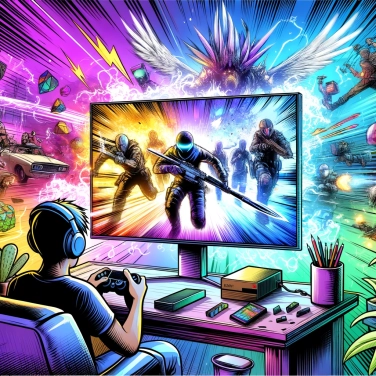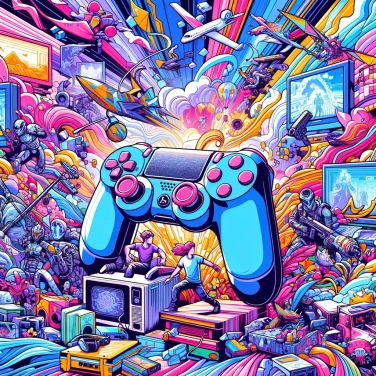Some video games slow down during intense scenes due to an overload of calculations to display complex graphics and perform fast calculations. This can lead to a decrease in game performance, causing slowdowns and frame rate drops.

When a video game becomes action-packed, with lots of characters, visual details, and interactive events to manage simultaneously, the processor (or CPU) works hard. Each added element forces the processor to perform more complex calculations, such as collision detection, artificial intelligence, or tracking interactions. If it reaches its limits, it struggles to keep up: as a result, the game loses its smoothness and runs slowly. It's like asking your brain to solve ten complicated math problems at once; it inevitably gets stuck.
Your hardware imposes its own limits, meaning that even a high-end graphics card or a cutting-edge processor does not have infinite power. When faced with games featuring ultra-realistic graphics, detailed textures, and complex worlds, even good hardware can struggle to keep up. Your graphics card (GPU) is responsible for most of the graphical calculations: real-time rendering, lighting management, shadows, special effects... When it reaches its limit, it lags and causes those infamous slowdowns because it simply can't manage all those pixels and visual effects simultaneously. As for the central processor (CPU), it has to handle the game's logic, artificial intelligence, physical interactions between characters or objects, and if it becomes overloaded, you'll quickly notice sudden drops in fps. Another important factor is random access memory (RAM): if your RAM is insufficient or already running at full capacity, your game will have to constantly load and unload resources, which will definitely impact smoothness.
Special effects like explosions, smoke, or light particles and physical calculations require significant processing power from the CPU and GPU. When a fight scene intensifies with debris everywhere, the hardware must quickly calculate trajectories, collisions, smooth movements, or realistic reactions of colliding objects. All of these operations consume a tremendous amount of hardware resources. The result: the game starts to lag, losing its fluidity, and the gap between what the hardware can handle and what the game demands causes a noticeable slowdown. The more elements there are to manage simultaneously, the harder the hardware struggles.
A video game uses a huge amount of graphic resources (textures, models, visual effects...). If these resources are loaded unnecessarily or poorly organized, it overloads the memory and slows down the game. For example, some games load very high-resolution textures, even on small distant objects whose details no one notices. As a result, the graphics card wastes its time handling unnecessary content instead of focusing on important elements. Another common example is poorly optimized games that keep in memory objects or characters absent from the current scene, which wastes resources and slows down performance. In short, inefficient resource management unnecessarily strains the machine, consuming valuable resources and making gameplay frustrating where it could be smooth.
Recent games often push graphical quality very far. But beware, beautiful images mean highly detailed textures, sometimes too heavy for the hardware. The higher the textures are in high resolution, the more they tax the video memory and the graphics processor (GPU) to load, display, and refresh in real-time. The result: it heavily strains the video RAM (VRAM), and your PC or console sometimes struggles to keep up. Ultra-detailed textures look great, yes, but your game lags as soon as the action speeds up and everything needs to be displayed quickly. When you have lots of hyper-clear visual elements appearing at the same time, the GPU quickly becomes saturated, unable to process all that massive data at once. So, in trying too hard to excel graphically, you end up stuck with drops in frame rate, going from smooth action to that slideshow effect you hate so much.
During video game development, programmers often deliberately introduce controlled slowdowns to mask the loading times of subsequent elements and provide a smoother experience without visible pauses.
Slightly reducing the graphic resolution or disabling certain advanced graphic options (such as real-time shadows or particle effects) can significantly improve the frames per second (FPS) during intense scenes without heavily compromising visual quality.
The optimization of textures, known as 'mipmapping', involves creating reduced versions of textures for distant objects, which improves performance by decreasing the load on graphic memory.
Some modern game engines use dynamic optimization algorithms that automatically reduce scene complexity to maintain acceptable fluidity when hardware performance is insufficient.
Even a recent graphics card can experience slowdowns if the processor is insufficient or if there are bottlenecks related to RAM or storage. It could also be due to a lack of software optimization in the game.
Yes, low FPS (frames per second) indicates a consistent overall lack of fluidity, while a momentary slowdown often occurs only in certain complex sections of the game, usually due to a temporary system overload.
Absolutely. A lack of RAM forces the system to use virtual memory, which is much slower, resulting in slowdowns and temporary freezes during the most demanding moments.
Not necessarily. Consoles have fixed specifications, which makes optimization easier. PCs, being modular, can yield very variable results depending on the hardware configurations chosen by the user, sometimes leading to more slowdowns when they are not well-suited.
Yes, reducing the graphic resolution decreases the load on the graphics card, which often improves the smoothness of the game, especially during action-packed scenes or special effects.

0% of respondents passed this quiz completely!
Question 1/5